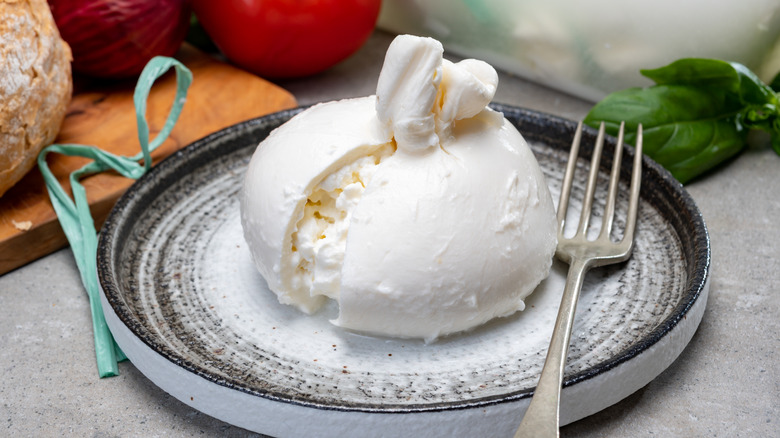What's The Difference Between Burrata And Mozzarella?
When you think about countries known for producing delicious cheese, you might first think of France, the land of brie, Roquefort, Camembert, and chevre. The Italians, however, would probably dispute France's arguable cheese superiority because of the popularity of Parmigiano Reggiano, mozzarella, gorgonzola, ricotta, and burrata (via Taste Atlas). While the winner isn't clear due to the subjectivity of it all, most people can agree that mozzarella is widely popular and has been since it was invented centuries ago. On the other hand, its cousin, burrata, is a relative newcomer to the large catalog of Italian cheeses.
Some people think that mozzarella and burrata are the same cheese, but they're actually pretty different. Technically, both mozzarella and burrata start out the same — they're made from freshly stretched curds from cow's milk. According to La Cucina Italia, burrata, considered mozzarella's more decadent relative, is actually made from mozzarella, has a creamier texture than mozzarella, and is best served and eaten while fresh as is feasibly possible. Conversely, mozzarella is used in cooking many Italian and non-Italian dishes, whereas burrata is seldom used as an ingredient; instead, it's eaten alongside things like fresh tomatoes, salads, and charcuterie.
The history of mozzarella and burrata
While the origins of mozzarella are up for debate, what we do know is that it has been around since at least the 12th century by name, though earlier iterations of the cheese might date back as far as the first century (via the Italian Tribune). Burrata, on the other hand, was first created in the 1920s in Andria, Puglia by an inventive cheesemaker named Lorenzo Bianchino Chieppa. According to the BBC, Chieppa's creation was borne from his attempts to use leftovers from the cheesemaking process in order to cut down on food waste. Mining that vein, he encased stracciatella, the name for throwaway cream-soaked curds, into balls of stretched mozzarella — and just like that, burrata was born.
While most of the mozzarella found in the U.S. is made from cow's milk, real traditional mozzarella is made from buffalo's milk. The full name for what we call mozzarella is actually mozzarella di bufala — with bufala meaning "buffalo" in English — and authentic mozzarella is usually marked as such. According to VinePair, a typical consumer can tell if mozzarella is from a very specific part of Italy and follows both a very strict recipe and cheesemaking technique if it's marked with a "Protected Designation of Origin" status, or PDO for short. (Think: how real champagne only comes from the Champagne region of France.)
Uses for mozzarella and burrata
It's not accurate to say that mozzarella and burrata are interchangeable as ingredients — but in some situations, swapping burrata for your mozzarella can be an upgrade. A caprese salad, for example, is seen by some as a symbol of summer, and is typically plated in layered tomato slices, fresh basil, and cuts of mozzarella, dressed in drizzles of olive oil and balsamic vinegar. But if you replace the mozzarella with burrata, you've just kicked it up to a whole new level of decadence — an opinion thoroughly endorsed by Italian American culinary staples like Eataly.
Mozzarella's popularity as an ingredient doesn't just stop with Italian dishes like pizza and lasagna. You can find the cheese varietal in dishes from many different cultural backgrounds, among them quesadillas, quiches, and mac and cheese. The common thread through dishes that use mozzarella is the cheese's melty quality.
Unlike mozzarella, however, burrata is best served at room temperature in order to bring out its tangy-yet-creamy, delicate flavors. That said, adding burrata to a pizza fresh out of the oven is a delightful exception to this rule. If you want to experiment with burrata, consider certain flavor profiles. Take, for instance, one especially delightful pairing: adding burrata to a prosciutto pizza, which contains both salty and meaty notes that compliment burrata perfectly.


